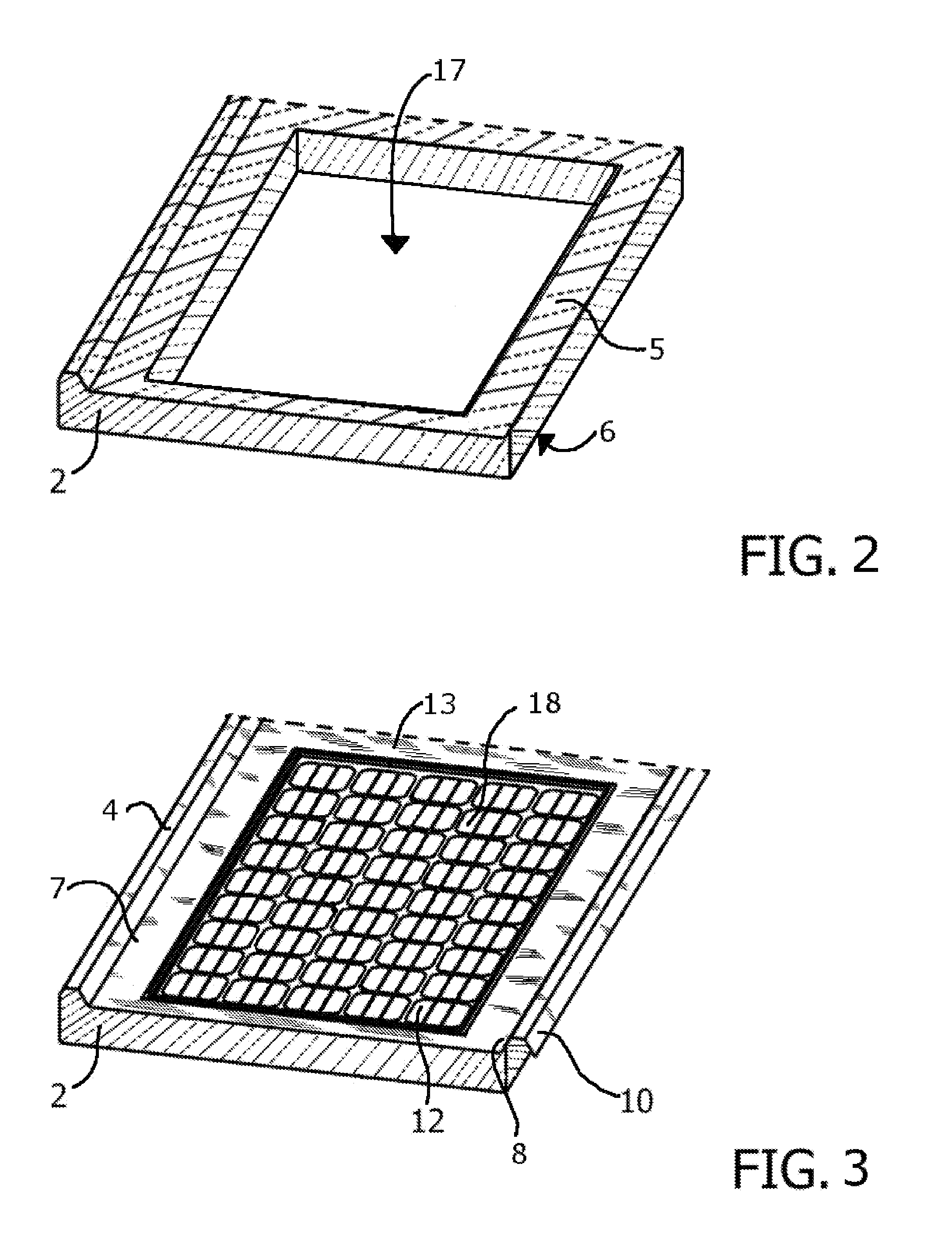Insulating construction panel with photovoltaic module
a technology of photovoltaic modules and construction panels, which is applied in the direction of photovoltaic supports, sustainable buildings, pv power plants, etc., can solve the problems of unattractive and unattractive bulkiness of traditional crystalline photovoltaic modules, high installation cost and time consumption of photovoltaic modules to pre-existing structures, and reduce the overall cost and time of construction. , to achieve the effect of improving the power generation efficiency of crystalline photovoltaic modules
- Summary
- Abstract
- Description
- Claims
- Application Information
AI Technical Summary
Benefits of technology
Problems solved by technology
Method used
Image
Examples
first embodiment
[0034] depicted in FIGS. 1 through 4 and 7, the opening 17 defined by the insulating core 2 extends from the top surface 5 of the insulating core 2 through to the bottom surface 6 as shown in FIGS. 2 and 4. The crystalline photovoltaic module 12, fitted within the insulating core 2, therefore, is non-insulated at its outer surface 18 and inner surface 19. Such an embodiment would be preferable in warmer environments as the non-insulated inner surface 19 can be ventilated from being exposed to the interior of the structure in which it is incorporated. In some such embodiments, the height of the crystalline photovoltaic module 12 essentially matches the height of the insulating core 2, such that, when the crystalline photovoltaic module 12 is fitted within the opening 17 of the insulating core 2, the outer surface 18 of the crystalline photovoltaic module 12 is essentially flush with the top surface 5 of the insulating core 2 and the inner surface 19 of the crystalline photovoltaic mo...
third embodiment
[0035] depicted in FIGS. 1, 3, and 8, the opening 17 defined by the insulating core 2 extends from the top surface 5 into the interior of the insulating core 2, but not through to the bottom surface 6. As such, when the crystalline photovoltaic module 12 is fitted within the insulating core 2, the inner surface 19 is covered and therefore insulated by the insulating core 2. Such an embodiment would be preferably in cooler environments where overheating of the crystalline photovoltaic module 12 is not a large concern.
second embodiment
[0036] depicted in FIGS. 1 through 3, 5 and 6, the insulating construction and solar panel 1 further includes at least one adjustable insulating shutter 11 connected to the insulating core 2. The adjustable insulating shutter 11 is configured so that it can be selectively moved from a closed position, such as that shown in FIG. 6, to at least one open position, such as that shown in FIG. 5. In the closed position (FIG. 6), the adjustable insulating shutter 11 covers and insulates the inner surface 19 of the crystalline photovoltaic module 12. Thus, the closed position (FIG. 6) is ideal for use during instances of cooler environmental conditions. In the open positions, such as that shown in FIG. 5, the inner surface 19 of the crystalline photovoltaic module 12 is at least partially uncovered so as to leave the inner surface 19 of the crystalline photovoltaic module 12 at least partially exposed. The open positions are ideal for use during instances of warmer environmental conditions,...
PUM
 Login to View More
Login to View More Abstract
Description
Claims
Application Information
 Login to View More
Login to View More - R&D
- Intellectual Property
- Life Sciences
- Materials
- Tech Scout
- Unparalleled Data Quality
- Higher Quality Content
- 60% Fewer Hallucinations
Browse by: Latest US Patents, China's latest patents, Technical Efficacy Thesaurus, Application Domain, Technology Topic, Popular Technical Reports.
© 2025 PatSnap. All rights reserved.Legal|Privacy policy|Modern Slavery Act Transparency Statement|Sitemap|About US| Contact US: help@patsnap.com



